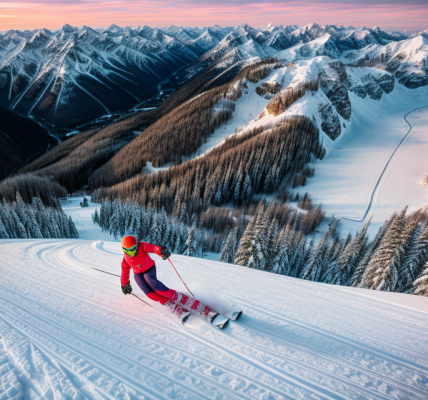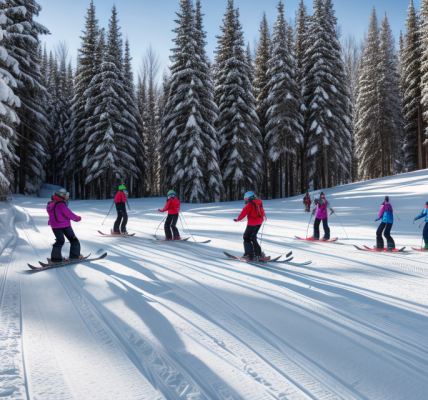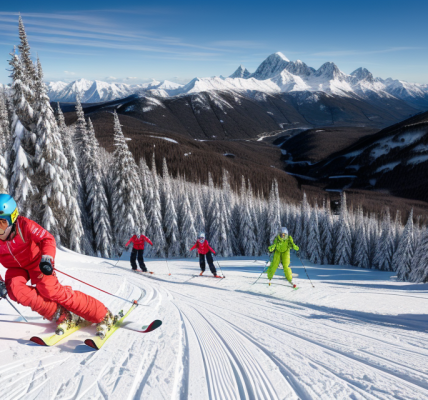Are you tired of feeling like you’re going too fast while skiing and struggling to control your speed? It’s a common problem for many skiers, but with the right techniques and tips, you can learn how to control your speed and ski with confidence. In this article, we’ll provide you with practical advice on how to slow down and maintain control while skiing. From adjusting your stance to using the right equipment, we’ll cover everything you need to know to ski at a comfortable pace. So, whether you’re a beginner or an experienced skier, read on to discover how to take control of your speed and enjoy a more relaxed and enjoyable skiing experience.
Understanding the Basics of Skiing Speed
Factors Affecting Skiing Speed
- Terrain
- The slope of the terrain plays a significant role in determining the speed at which a skier can travel. Steeper slopes tend to result in faster speeds, while gentler slopes allow for more control and slower speeds.
- The layout of the terrain can also impact speed. For example, a trail with a lot of twists and turns will likely slow down a skier more than a straight trail.
- Snow Conditions
- The type of snow can also affect skiing speed. Fresh powder or soft snow can slow down a skier due to the resistance it creates, while icy or hard-packed snow can increase speed.
- The density of the snow can also impact speed. A dense snowpack can make it more difficult for a skier to maintain control and control their speed.
- Skier’s Technique and Style
- A skier’s technique and style can have a significant impact on their speed. An inexperienced skier may not have the proper technique to control their speed, resulting in a faster pace. On the other hand, an experienced skier with proper technique can control their speed more effectively.
- The skiing style of a skier can also impact speed. For example, a skier who prefers a more aggressive style may be able to maintain higher speeds, while a skier with a more conservative style may prefer to maintain slower speeds.
Importance of Speed Control in Skiing
Proper speed control is essential in skiing to avoid accidents and injuries. When skiing down a slope, it is crucial to maintain a speed that allows for proper control and maneuverability. If you ski too slowly, you may lose balance or have difficulty turning, while skiing too quickly can make it difficult to maintain control and increase the risk of accidents.
Speed control is also important for improving skiing technique. By controlling your speed, you can practice different skiing techniques, such as turning and stopping, in a controlled environment. This helps you develop your skills and become a more confident and competent skier.
Lastly, speed control is essential for enjoying the sport. Skiing is meant to be a fun and exhilarating experience, and proper speed control allows you to fully enjoy the sport without putting yourself in danger. By controlling your speed, you can take in the beautiful scenery and enjoy the thrill of skiing without the fear of accidents or injuries.
Controlling Your Speed While Skiing
Mastering the Poling Technique
Introduction to Poling
Poling is a technique used by skiers to control their speed and maintain balance while skiing. It involves using a ski pole to push against the snow, which helps the skier to slow down or stop when needed. Poling is a crucial skill for skiers of all levels, as it allows them to maintain control over their speed and direction on the slopes.
Steps to Master the Technique
- Start by standing in a skiing position with your feet shoulder-width apart and your weight evenly distributed on both skis.
- Hold your ski poles with a comfortable grip, keeping your arms extended in front of you.
- As you begin to slow down, plant your ski pole into the snow and push down with a straight arm.
- Use your other ski pole to balance yourself and maintain your position on the slope.
- As you become more comfortable with the technique, you can practice using both poles simultaneously to slow down or stop quickly.
Common Mistakes to Avoid
- Not using the correct grip on the ski poles can make it difficult to master the poling technique. Make sure to hold the poles with a firm but comfortable grip.
- Not pushing down hard enough on the ski pole can make it difficult to slow down or stop. Practice pushing down with a straight arm to ensure maximum force.
- Relying too heavily on the poling technique can lead to a loss of balance and control on the slopes. Make sure to use poling in conjunction with other skiing techniques to maintain control over your speed and direction.
Adjusting Your Skiing Technique
One of the most effective ways to control your speed while skiing is by adjusting your skiing technique. Here are some tips on how to do it:
- Balancing Your Weight: One of the most important aspects of skiing is balancing your weight. When you’re skiing down a slope, you need to distribute your weight evenly across your skis to maintain control. To do this, focus on keeping your weight centered over your boots and avoid leaning too far forward or backward.
- Shifting Your Body Position: Another important technique for controlling your speed is by shifting your body position. When you’re going down a steep slope, you may need to shift your weight slightly forward to slow down or backward to speed up. Practice shifting your weight subtly to maintain control and stability.
- Using Edge Control: Edge control is another important technique for controlling your speed while skiing. When you’re skiing down a slope, you can use your edges to make turns and slow down. To do this, dig your edges into the snow and shift your weight to one side or the other. This will cause your skis to turn and slow down, giving you more control over your speed.
By adjusting your skiing technique and focusing on these tips, you can maintain control over your speed while skiing and prevent accidents. Remember to always be aware of your surroundings and ski responsibly.
Using Terrain and Snow Conditions to Your Advantage
Controlling your speed while skiing is essential for maintaining balance and avoiding accidents. One way to control your speed is by taking advantage of the terrain and snow conditions. Here are some tips for using terrain and snow conditions to your advantage:
Choosing the Right Terrain
The terrain you choose to ski on can have a significant impact on your speed. Here are some tips for choosing the right terrain:
- Start on gentle slopes: If you’re new to skiing or want to build your confidence, start on gentle slopes. These slopes will allow you to get a feel for the sport without having to worry about going too fast.
- Work your way up to steeper slopes: As you become more comfortable and confident, you can move on to steeper slopes. These slopes will allow you to challenge yourself and improve your skills.
- Avoid icy or rocky terrain: Icy or rocky terrain can be dangerous, as it can cause you to lose control and crash. Avoid these types of slopes if possible.
Adapting to Different Snow Conditions
The snow conditions can also affect your speed and control while skiing. Here are some tips for adapting to different snow conditions:
- Slow down in deep snow: Deep snow can be heavy and difficult to move through, so it’s important to slow down. Take smaller turns and avoid making large turns, which can be difficult to control in deep snow.
- Speed up on groomed slopes: Groomed slopes are smooth and easy to ski on, so you can speed up without worrying about losing control. Take longer, smoother turns and enjoy the speed.
- Adjust your technique for fresh snow: Fresh snow can be unpredictable, so it’s important to adjust your technique accordingly. Keep your weight centered over your skis and use shorter, quicker turns to maintain control.
Taking Advantage of Natural Features
The natural features of the ski slope can also help you control your speed. Here are some tips for taking advantage of natural features:
- Use natural terrain features to slow down: Natural terrain features like trees, rocks, and moguls can help you slow down. Use these features to your advantage by taking smaller, more controlled turns.
- Use natural terrain features to speed up: Natural terrain features like open slopes and powder can help you speed up. Use these features to your advantage by taking longer, smoother turns and letting gravity do the work.
- Be aware of changes in terrain: Changes in terrain, such as drop-offs or cliffs, can affect your speed and control. Be aware of these changes and adjust your technique accordingly.
By using terrain and snow conditions to your advantage, you can control your speed while skiing and improve your overall performance. Remember to always prioritize safety and never take unnecessary risks.
Utilizing Skiing Equipment to Control Speed
One of the most effective ways to control your speed while skiing is by utilizing the right equipment. Here are some tips on how to use your skiing equipment to control your speed:
Adjusting Bindings
Adjusting your bindings is crucial to maintaining control over your speed while skiing. You can adjust the DIN setting of your bindings to ensure that they release at the appropriate speed. It’s important to note that the DIN setting should be adjusted based on your weight, skiing ability, and terrain. A professional ski technician can help you adjust your bindings to ensure your safety on the slopes.
Choosing the Right Skis and Boots
Choosing the right skis and boots is essential to controlling your speed while skiing. Skis that are too long or too short can affect your speed and stability, so it’s important to choose a ski that is the right length and width for your ability level and skiing style. Similarly, boots that are too loose or too tight can affect your control, so it’s important to choose a boot that fits well and provides support.
Using Wax and Other Accessories
Using the right wax and other accessories can also help you control your speed while skiing. Different types of wax are designed for different snow conditions, so it’s important to choose the right wax for the snow you’ll be skiing on. Additionally, using a ski pole with a wrist strap can help you maintain control by providing an additional point of contact with the snow.
By utilizing the right skiing equipment, you can maintain control over your speed while skiing and improve your overall performance on the slopes.
Mental and Physical Preparation for Skiing
Staying Focused and Alert
Before hitting the slopes, it’s important to prepare both your mind and body for the physical demands of skiing. One of the key aspects of maintaining control over your speed while skiing is staying focused and alert. Here are some tips to help you do just that:
- Get plenty of rest: A good night’s sleep can help you stay alert and focused on the slopes.
- Eat a balanced breakfast: Fueling your body with nutritious foods can help you maintain energy levels throughout the day.
- Take breaks: If you’re feeling fatigued, take a break and hydrate.
- Avoid alcohol and drugs: Substance abuse can impair your judgment and reaction time, putting you and others at risk.
Warming Up and Cooling Down
Warming up and cooling down are essential components of any physical activity, including skiing. These activities help prevent injury and prepare your body for the physical demands of the sport. Here’s what you need to know:
- Warming up: Start with some light cardio, such as jogging or stretching, to get your blood flowing and muscles warmed up.
- Cooling down: After you’re finished skiing, take some time to stretch and cool down your muscles. This will help prevent soreness and improve your flexibility.
Stretching and Strength Training
In addition to warming up and cooling down, stretching and strength training can help you maintain control over your speed while skiing. Here are some tips to help you get started:
- Stretch regularly: Stretching can help improve your flexibility and prevent injury. Try to stretch your major muscle groups, such as your quadriceps, hamstrings, and calves, for at least 10-15 minutes each day.
- Strength train: Strength training can help improve your muscular endurance and prevent injury. Focus on exercises that target the muscles used in skiing, such as your legs, core, and upper body.
By following these tips, you can prepare both your mind and body for the physical demands of skiing and maintain control over your speed.
FAQs
1. What are some ways to control my speed while skiing?
There are several ways to control your speed while skiing, including:
- Gradually releasing pressure on the ski poles
- Shifting your weight from one ski to the other
- Using a technique called “edging” to dig the edges of the skis into the snow
- Taking shorter, quicker turns instead of long, wide turns
- Using a “snowplough” or “Christmas tree” technique to slow down
- Using the “wedge” or “snowplough” position to slow down and regain control
- Taking breaks and resting when necessary
- Being aware of the terrain and skiing at a speed that is appropriate for it
2. How can I avoid going too fast on steep slopes?
To avoid going too fast on steep slopes, you can try the following:
- Starting at the top of the slope and skiing down in small, controlled increments
- Avoiding skiing on icy or hard-packed snow, which can make it easier to lose control
- Being mindful of your body position and using your legs and knees to control your speed
- Avoiding distractions such as talking or texting while skiing
3. How can I regain control if I feel like I’m going too fast?
If you feel like you’re going too fast, you can try the following to regain control:
- Slowing down by taking shorter, quicker turns
- Using your legs and knees to control your speed
- Being aware of your body position and keeping your weight centered over your skis




